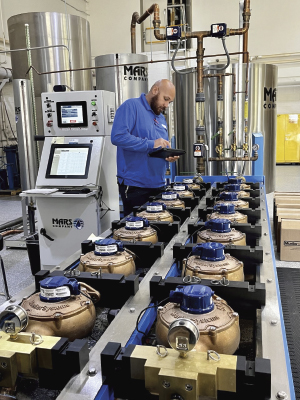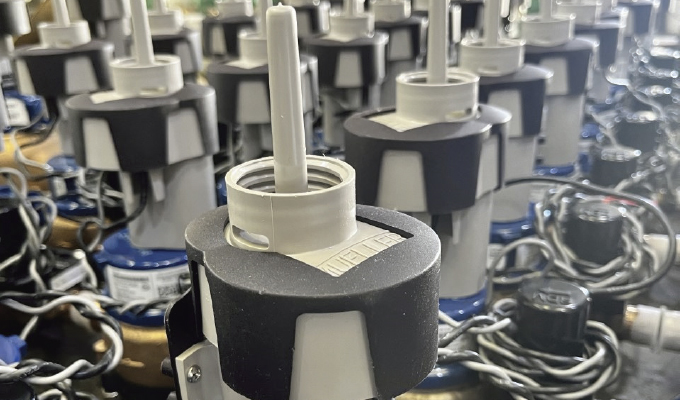Newport News Waterworks (NNWW) is a regional water provider on the lower Virginia Peninsula, owned and operated by the city of Newport News, that serves over 410,000 people in Hampton, Newport News, Poquoson, York County, and part of James City County.
With a service area encompassing over 250 square miles, and over 133,000 metered accounts, NNWW plays a vital role in ensuring an adequate supply of high-quality drinking water to residents and businesses across the region.
MOVING AWAY FROM MANUAL
Approximately eight years ago NNWW started having discussions about moving away from reading their mechanical, manually read meters every other month to go to monthly billing. Knowing they did not have adequate staffing to handle that task, the department decided to outsource its meter reading responsibilities to a third party. That led to other challenges as the contractor(s) often had difficulty with their own staffing levels, which caused schedule and timeliness issues, resulting in the customer’s bill window being longer than 30 days and/or the utility having to estimate.
While this was transpiring NNWW was proactively researching and conducting a feasibility study to determine if upgrading meter technology at that time was the right move.
Shawn Rohrbach, general services administrator with Newport News Waterworks, says, “The timing was perfect, the old meters had been in the ground for approximately fifteen to twenty years which is the life expectancy, so they needed to be replaced. The new technology offers a lot more capabilities, is more accurate, and we knew it would help reduce our costs and improve our level of service.”
INCREASING EFFICIENCY

Another major factor in making the move was the idea of having an internal valve in every residential meter. In 2018 NNWW’s Meter Operations branch performed over 90,000 service orders and 65 percent of those involved rolling a truck to turn a meter off or on, and/or take a meter read. Using a smart meter with an integrated valve, a lot of that work becomes automated.
After an extensive RFP process, NNWW selected the Mueller Systems’ Sentryx Water Intelligence Platform and Mueller meters to lead them into this digital age. In doing so NNWW became the utility with the largest Remote Disconnect Meter population in the country. Over 118,000 of their 133,000 meters will have an internal valve.
Rohrbach adds, “If a customer calls to say they have a water emergency, like a pipe burst, a waterworks employee can sit at their desk, with the customer still on the phone, and with a click of a button can turn their water off in under forty-five seconds.”
While the old mechanical meters cost less, the new RDM meter provides a significant upgrade to the functionality and efficiency. The city has been installing these meters for the last four years and the water rates have not changed since then. “I’m not going to say the water rate will never change because there’s inflation, supply chain issues, and the cost of other projects, but I can assure the public that the advanced metering infrastructure (AMI) project is not causing any more additional rate changes to our customers.”
BRINGING COSTS DOWN
The success of NNWW’s AMI project is underscored by its ability to recoup costs through tangible savings in labor and operational expenditure. With remote disconnect capabilities and automated service provisioning, NNWW has streamlined its operations while enhancing service reliability and responsiveness.
Over 50 percent of NNWW premises are classified as rental. There is a large transient population with many customers in military service, so there’s a lot of fluctuations from people coming in and out. In 2023 Newport News Waterworks performed over 32,000 move-in/out service orders as well as almost 40,000 non-pay cut-offs and reconnects.
“There’s not a single person at Waterworks that likes to go and turn somebody’s water off for non-payment, customers are understandably upset. Eliminating this task with automation is helpful in more ways than just eliminating those truck rolls. Also, with the current labor shortage in our area, no one wants to perform this type of work anymore; being in a meter box, crouched down reading meters, moving dirt, and getting wet; encountering snakes and spiders, and just being in the extreme environment of the area, be it the heat, rain, or freezing temperatures. AMI helps us keep the level of service our customers expect, while dealing with staff shortages,” Rohrbach explains.
BUILT-IN REDUNDANCY
Central to NNWW’s AMI implementation is the Mueller Mi.Net® platform, a robust communication network of thirty-four collectors and ninety-seven repeaters strategically positioned to ensure comprehensive coverage. This infrastructure enables real-time data retrieval, empowering both customers and utility personnel with actionable insights for informed decision-making. Moreover, the system’s resilience and redundancy ensure uninterrupted service delivery, even in the face of unforeseen contingencies.
Mueller Systems helped design a network with built-in redundancy for 80 percent of the service area so it can communicate with more than one network device. The meters can also store 511 days’ worth of data and automatically backfill the reads if for some reason it cannot connect to a network device. The new AMI system can also be an AMR (drive-by) system without doing any re-configurations.
THE RIGHT AMOUNT OF INFORMATION
The smart meter will pick up very granular usage of water, like a toilet leak, which is helpful for a customer because that’s a cost to them. However, Waterworks quickly found out that too much granular information can cause other issues.
“Death by alarm is what we termed it,” Rohrbach states, “As thousands of meters were being installed, we were getting hundreds of possible meter leak alarms in Sentryx. In the beginning, we tried to investigate them all but quickly realized we didn’t have the manpower to keep up. When we did investigate them, we quickly realized nearly 99 percent of the leaks were on the customer side of the meter.”
Concurrently, NNWW upgraded its customer portal, empowering customers with real-time access to their hourly, daily, and monthly water usage data. Moreover, customers could opt for alarms and alerts for leak detection, enhancing awareness and conservation efforts. “A lot of local plumbers probably got an uptick in business once customers signed up to our upgraded customer portal and could see their water usage and possible water leaks.” Other added benefits included out of town alerts for water usage or pre-arranged water turn off/on if the customer is going out of town for an extended period.
“Some customers say Big Brother is now watching my water usage and I can assure you with 133,000 customers, we have way too much work to sit there and worry about who’s using water and when. Most of the time we do not investigate anybody’s water usage until we get called about an issue,” says Rohrbach. “We’re trying to put more power in the hands of the users so they can watch their own consumption and be notified if there’s a potential issue before they get a large bill. They can be the first eyes on the scene, and if it’s a city issue, then they call us.”
READY FOR THE FUTURE
Waterworks continuously test the meters for accuracy. They test approximately 10 percent of the residential meters and nearly 100 percent of the larger size meters before they go into the ground. No meter gets installed if it does not pass the American Water Works Association (AWWA) standards. Anytime a meter is taken out of service, it goes back to the meter shop and is tested for accuracy before it goes back into the field. If it fails and it’s still under warranty Mueller will replace it with a brand-new meter. This is a revenue protection measure to make sure everybody is getting charged the right amount for their water usage.
As NNWW nears the completion of its AMI rollout, the future of water management in the region looks promising. By embracing innovation, leveraging technology, and prioritizing customer-centric solutions, NNWW is paving the way for a more sustainable and resilient water future.
“The project is progressing smoothly,” remarks Rohrbach. “Like any undertaking, we’ve encountered a few bumps along the road. However, each time an issue arises, our team comes together seamlessly to address it. The goal is to learn from our mistakes and ensure they’re not repeated. If a problem arises, our approach is to promptly resolve it and establish protocols to prevent its recurrence. Thus far, our strategy has proven effective and overall, we have had a successful project.”
Rossie Manning is technology solutions regional director for Mueller Water Products. Mueller Water Products is a leading manufacturer and marketer of products and services used in the transmission, distribution, and measurement of water in North America. The company’s broad product and service portfolio includes engineered valves, fire hydrants, metering products and systems, leak detection, and pipe condition assessment. It helps municipalities increase operational efficiencies, improve customer service, and prioritize capital spending, demonstrating why Mueller Water Products is “Where Intelligence Meets Infrastructure.” For more information, visit www.muellerwaterproducts.com.


